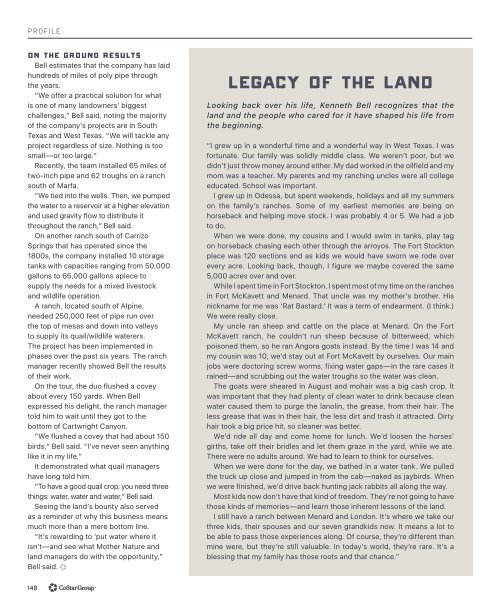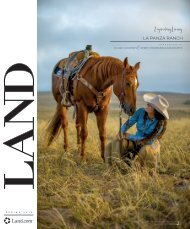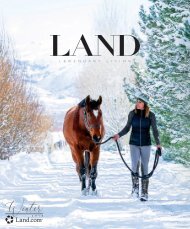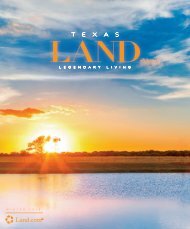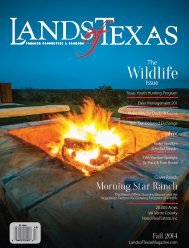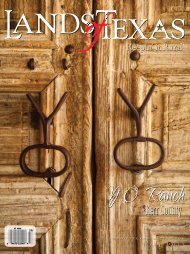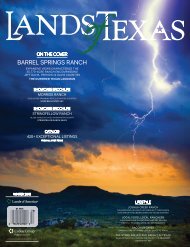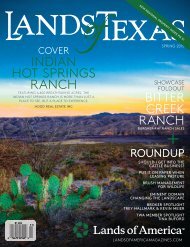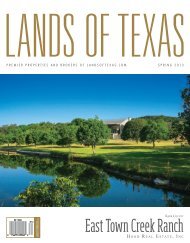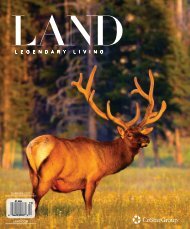Create successful ePaper yourself
Turn your PDF publications into a flip-book with our unique Google optimized e-Paper software.
PROFILE<br />
ON THE GROUND RESULTS<br />
Bell estimates that the company has laid<br />
hundreds of miles of poly pipe through<br />
the years.<br />
“We offer a practical solution for what<br />
is one of many landowners’ biggest<br />
challenges,” Bell said, noting the majority<br />
of the company’s projects are in South<br />
<strong>Texas</strong> and West <strong>Texas</strong>. “We will tackle any<br />
project regardless of size. Nothing is too<br />
small—or too large.”<br />
Recently, the team installed 65 miles of<br />
two-inch pipe and 62 troughs on a ranch<br />
south of Marfa.<br />
“We tied into the wells. Then, we pumped<br />
the water to a reservoir at a higher elevation<br />
and used gravity flow to distribute it<br />
throughout the ranch,” Bell said.<br />
On another ranch south of Carrizo<br />
Springs that has operated since the<br />
1800s, the company installed 10 storage<br />
tanks with capacities ranging from 50,000<br />
gallons to 65,000 gallons apiece to<br />
supply the needs for a mixed livestock<br />
and wildlife operation.<br />
A ranch, located south of Alpine,<br />
needed 250,000 feet of pipe run over<br />
the top of mesas and down into valleys<br />
to supply its quail/wildlife waterers.<br />
The project has been implemented in<br />
phases over the past six years. The ranch<br />
manager recently showed Bell the results<br />
of their work.<br />
On the tour, the duo flushed a covey<br />
about every 150 yards. When Bell<br />
expressed his delight, the ranch manager<br />
told him to wait until they got to the<br />
bottom of Cartwright Canyon.<br />
“We flushed a covey that had about 150<br />
birds,” Bell said. “I’ve never seen anything<br />
like it in my life.”<br />
It demonstrated what quail managers<br />
have long told him.<br />
“To have a good quail crop, you need three<br />
things: water, water and water,” Bell said.<br />
Seeing the land’s bounty also served<br />
as a reminder of why this business means<br />
much more than a mere bottom line.<br />
“It’s rewarding to ‘put water where it<br />
isn’t—and see what Mother Nature and<br />
land managers do with the opportunity,”<br />
Bell said. °<br />
LEGACY OF THE <strong>LAND</strong><br />
Looking back over his life, Kenneth Bell recognizes that the<br />
land and the people who cared for it have shaped his life from<br />
the beginning.<br />
“I grew up in a wonderful time and a wonderful way in West <strong>Texas</strong>. I was<br />
fortunate. Our family was solidly middle class. We weren’t poor, but we<br />
didn’t just throw money around either. My dad worked in the oilfield and my<br />
mom was a teacher. My parents and my ranching uncles were all college<br />
educated. School was important.<br />
I grew up in Odessa, but spent weekends, holidays and all my summers<br />
on the family’s ranches. Some of my earliest memories are being on<br />
horseback and helping move stock. I was probably 4 or 5. We had a job<br />
to do.<br />
When we were done, my cousins and I would swim in tanks, play tag<br />
on horseback chasing each other through the arroyos. The Fort Stockton<br />
place was 120 sections and as kids we would have sworn we rode over<br />
every acre. Looking back, though, I figure we maybe covered the same<br />
5,000 acres over and over.<br />
While I spent time in Fort Stockton, I spent most of my time on the ranches<br />
in Fort McKavett and Menard. That uncle was my mother’s brother. His<br />
nickname for me was ‘Rat Bastard.’ It was a term of endearment. (I think.)<br />
We were really close.<br />
My uncle ran sheep and cattle on the place at Menard. On the Fort<br />
McKavett ranch, he couldn’t run sheep because of bitterweed, which<br />
poisoned them, so he ran Angora goats instead. By the time I was 14 and<br />
my cousin was 10, we’d stay out at Fort McKavett by ourselves. Our main<br />
jobs were doctoring screw worms, fixing water gaps—in the rare cases it<br />
rained—and scrubbing out the water troughs so the water was clean.<br />
The goats were sheared in August and mohair was a big cash crop. It<br />
was important that they had plenty of clean water to drink because clean<br />
water caused them to purge the lanolin, the grease, from their hair. The<br />
less grease that was in their hair, the less dirt and trash it attracted. Dirty<br />
hair took a big price hit, so cleaner was better.<br />
We’d ride all day and come home for lunch. We’d loosen the horses’<br />
girths, take off their bridles and let them graze in the yard, while we ate.<br />
There were no adults around. We had to learn to think for ourselves.<br />
When we were done for the day, we bathed in a water tank. We pulled<br />
the truck up close and jumped in from the cab—naked as jaybirds. When<br />
we were finished, we’d drive back hunting jack rabbits all along the way.<br />
Most kids now don’t have that kind of freedom. They’re not going to have<br />
those kinds of memories—and learn those inherent lessons of the land.<br />
I still have a ranch between Menard and London. It’s where we take our<br />
three kids, their spouses and our seven grandkids now. It means a lot to<br />
be able to pass those experiences along. Of course, they’re different than<br />
mine were, but they’re still valuable. In today’s world, they’re rare. It’s a<br />
blessing that my family has those roots and that chance.”<br />
148


